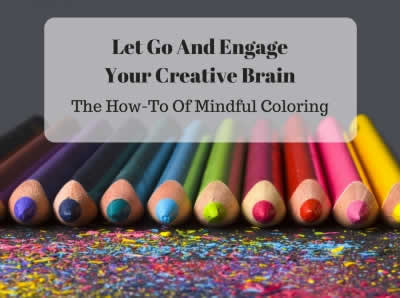
In 2015 a whole new genre was created: Mindful coloring books for adults. Essentially, these coloring books depict patterns and abstract designs, such as in mandala coloring books, rather than realistic images to color in. And, the pictures in these coloring books generally don’t have any “correct” way to color them.
The rise in popularity of mindful coloring books comes on the tail of an increasing interest and practice of mindfulness in the West. Mindfulness is a meditation practice that involves focusing your attention, with nonjudgmental awareness, on the present moment. This practice has its roots in Buddhism, but has become popular in the West due to its positive impact on mood and general wellness. Over the past several years, there has been a huge growth of interest in mindfulness, partially due to the increasing body of evidence that the practice can help with many common health problems, like stress, depression, anxiety and chronic pain.
One of the reasons why mindfulness is such a powerful practice is that it helps practitioners become more aware of the thought patterns that run in the back of their minds and to change their relationship to them. The self-critic is a particular thought patterns that tends to put the brakes on any creative endeavor—coloring included. The practice of mindful coloring, then, presents an opportunity to focus on what you are doing in the present moment (coloring) and to notice when your attention gets swept away by the self-critic (or any other habitual train of thought) and to practice bringing yourself right back to the present moment.
It’s important to note here that no coloring book will practice mindfulness for you. Mindfulness is less about what you are doing with your hands and more about what you are doing with your mind and attention while you are coloring. It’s about practicing awareness of your actions and your thoughts as they are happening. While you can practice mindful coloring with any coloring book, specific coloring books make it a bit easier. For many of us, we struggle with thought habits about “should.” We think about the way we, things or the world should be. With this in mind, many of the designers of mindful coloring books carefully drew the images to not have a specific right or wrong way to color them. Unlike a picture of a landscape, there’s no predetermined “supposed to’s” about how to color. This gives you, the mindful artist, the chance to really explore with colors or shapes that you aren’t used to. You get the space to be creative and practice disengaging from the “should” trains of thought.
Try It: Simple steps to developing a mindful coloring practice
Get your supplies, and don’t limit yourself to crayons. While adult coloring books have become a huge market, so have coloring supplies. Colored pencil sales, for example, leaped almost 27 percent in sales last year. Some favorites of mine are Crayola twistables, and, if you want to splurge, prism colored pencils.
Choose a time to color when you are unlikely to be disturbed. Begin with a brief mindfulness practice. If you have never practiced mindfulness meditation before, click here to learn about the practice. Close your eyes. Take a few intentional breaths, noticing how your body feels to be breathing in that moment.
Open your eyes and look at the tools you have in front of you. Pick up your coloring book and open to any page that appeals to you.
Once you decide on a design to color, turn your attention to your tools. Look at each pencil or crayon or pen with a sense of curiosity. Notice how you react to each one. Do any colors attract or repel you? There’s no need to do anything about your response; just notice it. Eventually select one color that attracts you. Pick it up. Look at it closely.
Turn your attention back to the page. Choose a shape that appeals to you. Slowly, with awareness, place your tool to the paper. Notice how your hand holds the tool. Notice how the muscles in your arm move in synchrony to place the tool to the paper.
Notice the impulse to move your hand before you follow through with motion.
Slowly, with intention, move your tool across the paper and make your first stroke. As you move your hand, notice the feeling of friction as your tool moves across the paper. Once your first stroke is complete, pause and notice how you have spread color across the paper. Continue coloring the rest of the design. Whenever you notice yourself following a train of thought more than you are paying attention to the coloring, gently bring your attention back to the present moment.
Repeat—again and again.
Samara V. Serotkin, Psy.D. is a Seattle-based clinical psychologist and mindfulness-based coach. Dr.  Serotkin, the author of “The Relationship Between Self-Actualization and Creativity,” has served as an advisor to multiple startup companies and presented at national conferences on topics ranging from mindfulness meditation to creating behavioral change.
Serotkin, the author of “The Relationship Between Self-Actualization and Creativity,” has served as an advisor to multiple startup companies and presented at national conferences on topics ranging from mindfulness meditation to creating behavioral change.





